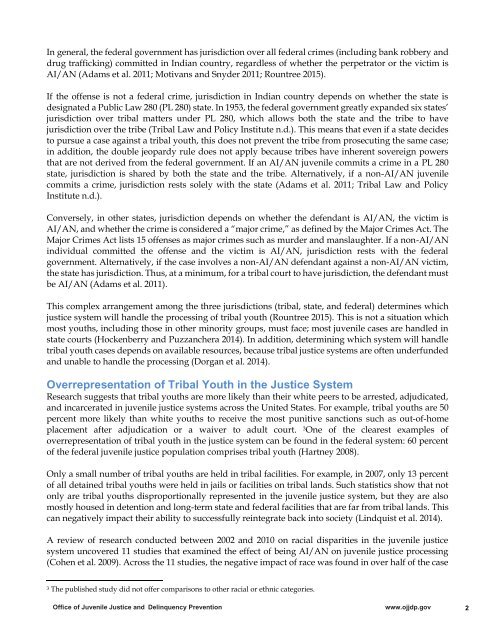Native American Youth In The Juvenile Justice System
Native American Youth In The Juvenile Justice System
Native American Youth In The Juvenile Justice System
Create successful ePaper yourself
Turn your PDF publications into a flip-book with our unique Google optimized e-Paper software.
<strong>In</strong> general, the federal government has jurisdiction over all federal crimes (including bank robbery and<br />
drug trafficking) committed in <strong>In</strong>dian country, regardless of whether the perpetrator or the victim is<br />
AI/AN (Adams et al. 2011; Motivans and Snyder 2011; Rountree 2015).<br />
If the offense is not a federal crime, jurisdiction in <strong>In</strong>dian country depends on whether the state is<br />
designated a Public Law 280 (PL 280) state. <strong>In</strong> 1953, the federal government greatly expanded six states’<br />
jurisdiction over tribal matters under PL 280, which allows both the state and the tribe to have<br />
jurisdiction over the tribe (Tribal Law and Policy <strong>In</strong>stitute n.d.). This means that even if a state decides<br />
to pursue a case against a tribal youth, this does not prevent the tribe from prosecuting the same case;<br />
in addition, the double jeopardy rule does not apply because tribes have inherent sovereign powers<br />
that are not derived from the federal government. If an AI/AN juvenile commits a crime in a PL 280<br />
state, jurisdiction is shared by both the state and the tribe. Alternatively, if a non-AI/AN juvenile<br />
commits a crime, jurisdiction rests solely with the state (Adams et al. 2011; Tribal Law and Policy<br />
<strong>In</strong>stitute n.d.).<br />
Conversely, in other states, jurisdiction depends on whether the defendant is AI/AN, the victim is<br />
AI/AN, and whether the crime is considered a “major crime,” as defined by the Major Crimes Act. <strong>The</strong><br />
Major Crimes Act lists 15 offenses as major crimes such as murder and manslaughter. If a non-AI/AN<br />
individual committed the offense and the victim is AI/AN, jurisdiction rests with the federal<br />
government. Alternatively, if the case involves a non-AI/AN defendant against a non-AI/AN victim,<br />
the state has jurisdiction. Thus, at a minimum, for a tribal court to have jurisdiction, the defendant must<br />
be AI/AN (Adams et al. 2011).<br />
This complex arrangement among the three jurisdictions (tribal, state, and federal) determines which<br />
justice system will handle the processing of tribal youth (Rountree 2015). This is not a situation which<br />
most youths, including those in other minority groups, must face; most juvenile cases are handled in<br />
state courts (Hockenberry and Puzzanchera 2014). <strong>In</strong> addition, determining which system will handle<br />
tribal youth cases depends on available resources, because tribal justice systems are often underfunded<br />
and unable to handle the processing (Dorgan et al. 2014).<br />
Overrepresentation of Tribal <strong>Youth</strong> in the <strong>Justice</strong> <strong>System</strong><br />
Research suggests that tribal youths are more likely than their white peers to be arrested, adjudicated,<br />
and incarcerated in juvenile justice systems across the United States. For example, tribal youths are 50<br />
percent more likely than white youths to receive the most punitive sanctions such as out-of-home<br />
placement after adjudication or a waiver to adult court. 3 One of the clearest examples of<br />
overrepresentation of tribal youth in the justice system can be found in the federal system: 60 percent<br />
of the federal juvenile justice population comprises tribal youth (Hartney 2008).<br />
Only a small number of tribal youths are held in tribal facilities. For example, in 2007, only 13 percent<br />
of all detained tribal youths were held in jails or facilities on tribal lands. Such statistics show that not<br />
only are tribal youths disproportionally represented in the juvenile justice system, but they are also<br />
mostly housed in detention and long-term state and federal facilities that are far from tribal lands. This<br />
can negatively impact their ability to successfully reintegrate back into society (Lindquist et al. 2014).<br />
A review of research conducted between 2002 and 2010 on racial disparities in the juvenile justice<br />
system uncovered 11 studies that examined the effect of being AI/AN on juvenile justice processing<br />
(Cohen et al. 2009). Across the 11 studies, the negative impact of race was found in over half of the case<br />
3 <strong>The</strong> published study did not offer comparisons to other racial or ethnic categories.<br />
Office of <strong>Juvenile</strong> <strong>Justice</strong> and Delinquency Prevention www.ojjdp.gov 2

















